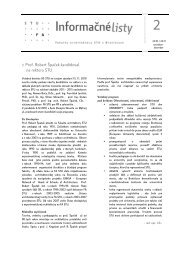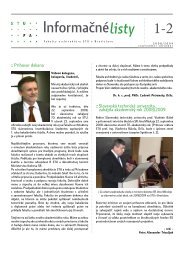ALFA 3-4/2005 - Fakulta architektúry STU
ALFA 3-4/2005 - Fakulta architektúry STU
ALFA 3-4/2005 - Fakulta architektúry STU
Create successful ePaper yourself
Turn your PDF publications into a flip-book with our unique Google optimized e-Paper software.
Ročník 9<br />
3-4 / <strong>2005</strong> ARCHITEKTONICKÉ LISTY FA <strong>STU</strong><br />
parents and grand-parents. Naturally, a desire of every person is<br />
to die among his close, loved and loving members of family, not in<br />
cool impersonal hospital room. Taking care of old parents is also<br />
a duty or responsibility of children, but sometimes it may become<br />
very difficult. Especially when children have their own families and<br />
work and they are not able to provide proper care to their dying<br />
member of family. Slovak people have to learn to recognize<br />
the best solution in specific situations and to decide what is really<br />
good for patient and for his family.<br />
Hospice – it is not a depository of ill and old people, it is an<br />
opportunity for dignified and valuable life till the end.<br />
FORMS AND METHODS OF THE RESEARCH<br />
. Study of the actual situation of the problem<br />
. Analysing the problem<br />
. Definition of the problem<br />
. Solving the problem<br />
. Discovery of the solution<br />
. Verification of the solution.<br />
HISTORY AND PHILOSOPHY OF HOSPIC<br />
THE EVOLUTION OF INSTITUTIONS FOR PATIENTS IN<br />
TERMINAL STAGE OF ILLNESS – HISTORY OF HOSPIC<br />
The roots of the hospice reach deep in to the history. It was<br />
the Christian charity that has been involved mostly.<br />
The core of the word “hospic“ is in the Latin word “hospes“ what<br />
means – a guest but also a refuge or asylum. It was originally used<br />
to describe a place of shelter for weary and sick travelers on<br />
difficult journeys.<br />
During the 1960's, Dr. Cicely Saunders, a British physician began<br />
the modern hospice movement by establishing St. Christopher's<br />
Hospice near London. St. Christopher's Hospice organized a team<br />
approach to professional caregiving, and was the first programme<br />
to use modern pain management techniques to compassionately<br />
care for the dying. St. Christopher’s Hospice in London has served<br />
as a model for the whole modern hospice movement. But Cicely<br />
Saunders also saw herself as standing on the shoulders of other<br />
giants. She felt inspired by the 19th century achievements of Mary<br />
Aikenhead and the Irish Sisters of Charity as well as Jeanne<br />
Garnier and Les Dames du Calvaire in France. She was<br />
influenced by the moral philosophy of Frankl, by the theology of<br />
Buber and she built on the pain research of Leriche.<br />
Across the countries of Europe, founding initiative began in many<br />
different settings: in hospitals, in home care, in nursing homes,<br />
and only infrequently in hospices. Medical leadership came from<br />
various sources: from anaesthesiology, from geriatrics, from<br />
- 48 -<br />
oncology, from public health. Different priorities were given to<br />
areas such as the role of nurses and other health professionals,<br />
the involvement of volunteers, and the importance of research.<br />
The first hospice in the United States was established in New<br />
Haven, Connecticut in 1974.<br />
NEEDS OF SERIOUSLY ILL AND DYING PATIENTS:<br />
The biological needs<br />
Every patient needs to receive food, to get rid of some products<br />
of metabolism, to breathe easily and also to keep up the body in<br />
activity so that its functions would not stop working. Very important<br />
biological need is a placid sleep and soothing a pain.<br />
Hospice care neither prolongs life nor hastens death. Hospice<br />
staff and volunteers offer a specialized knowledge of medical<br />
care, including pain management.<br />
Hospice addresses all symptoms of a disease, with a special<br />
emphasis on controlling a patient's pain and discomfort.<br />
The psychological needs<br />
The main psychological need and at the same time the main goal<br />
of hospice care is to improve the quality of a patient's last days by<br />
offering dignity and comfort.<br />
Hospice professionals help patients and their families to<br />
understand and to accept the course of illness, they believe in<br />
the individuality of each person served. While those affected by<br />
terminal illness struggle to come to terms, hospice gently helps<br />
them find their way at their own speed.<br />
The social needs<br />
Because of human beings are social creatures, usually nobody<br />
wants to live and die alone. That is why patients are interested in<br />
visitors and they need them.<br />
The spiritual needs<br />
The fear of death is often due to the fear of pain and<br />
abandonment. Hospice staff include bereavement and spiritual<br />
counselors who help patients and families come to terms with<br />
dying. They assist patients in finishing important tasks, saying<br />
their final goodbyes, healing broken family relationships,<br />
distributing precious objects, and completing a spiritual journey.<br />
Unfinished business can make dying harder and grieving more<br />
difficult for those left behind. Hospice staff recognizes that<br />
a person who comes to terms with dying has a less stressful<br />
death, and that the family benefits from a less complicated<br />
grieving process. A source of relief and comfort for many hospice

















